
The common blue butterfly or European common blue is a butterfly in the family Lycaenidae and subfamily Polyommatinae. The butterfly is found throughout the Palearctic and has been introduced to North America. Butterflies in the Polyommatinae are collectively called blues, from the coloring of the wings. Common blue males usually have wings that are blue above with a black-brown border and a white fringe. The females are usually brown above with a blue dusting and orange spots.

Lycaenidae is the second-largest family of butterflies, with over 6,000 species worldwide, whose members are also called gossamer-winged butterflies. They constitute about 30% of the known butterfly species.

The silver-studded blue is a butterfly in the family Lycaenidae. It has bright blue wings rimmed in black with white edges and silver spots on its hindwings, lending it the name of the silver-studded blue. P. argus can be found across Europe and east across the Palearctic, but it is most often studied in the United Kingdom where the species has experienced a severe decline in population due to habitat loss and fragmentation.

Ornithoptera alexandrae, the Queen Alexandra's birdwing, is the largest species of butterfly in the world, with females reaching wingspans slightly in excess of 25 cm to 28 cm. This birdwing is restricted to the forests of the Oro Province in eastern Papua New Guinea.

Battus philenor, the pipevine swallowtail or blue swallowtail, is a swallowtail butterfly found in North America and Central America. This butterfly is black with iridescent-blue hindwings. They are found in many different habitats, but are most commonly found in forests. Caterpillars are often black or red, and feed on compatible plants of the genus Aristolochia. They are known for sequestering acids from the plants they feed on in order to defend themselves from predators by being poisonous when consumed. The adults feed on the nectar of a variety of flowers. Some species of Aristolochia are toxic to the larvae, typically tropical varieties. While enthusiasts have led citizen efforts to conserve pipevine swallowtails in their neighborhoods on the West coast, the butterfly has not been the subject of a formal program in conservation or protected in legislation. The butterfly is however of "Special Concern" in Michigan, which is on the Northern limit of its range.
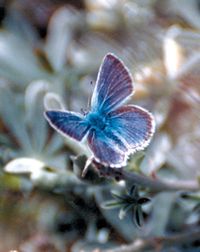
The Mission blue is a blue or lycaenid butterfly subspecies native to the San Francisco Bay Area of the United States. The butterfly has been declared as endangered by the US federal government. It is a subspecies of Boisduval's blue.
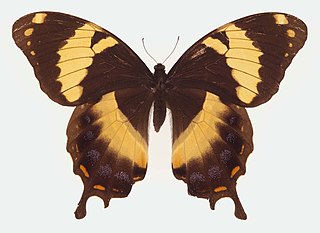
Papilio homerus, commonly known as the Homerus swallowtail or Jamaican swallowtail, is the largest butterfly species in the Western Hemisphere. The species is endangered and faces a potentially bleak future. Only two small populations of the Homerus swallowtail remain in a fraction of their original environment. It is endemic to Jamaica where the butterfly simultaneously serves as an icon of national pride and a need for conservation efforts. Over the past half century, the Jamaican swallowtail has been featured on various postal stamps and the Jamaican $1000 bill. In the face of rapid habitat destruction from human disruption and illegal collecting, the Jamaican swallowtail is listed on the Threatened Swallowtail Butterflies of the World by the International Union for Conservation of Nature and is protected under international and national level legislation.
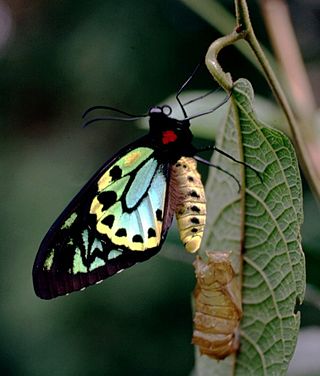
Ornithoptera richmondia, the Richmond birdwing, is a species of birdwing butterfly that is endemic to Australia. It is the second smallest of the birdwing species, the smallest being Ornithoptera meridionalis.

Acrodipsas is a genus of butterflies in the family Lycaenidae. There are ten species in this genus all endemic to the Australasian realm:

Phengaris rebeli, common name mountain Alcon blue, is a species of butterfly in the family Lycaenidae. It was first found and described in Styria, Austria, on Mount Hochschwab around 1700. Although it was initially classified as a subspecies of P. alcon, a European researcher, Lucien A. Berger, designated it as a separate species in 1946. Genetic similarities between P. rebeli and P. alcon have led many researchers to argue that the two are the same species and differences are due to intraspecific variation.

Jalmenus evagoras, the imperial hairstreak, imperial blue, or common imperial blue, is a small, metallic blue butterfly of the family Lycaenidae. It is commonly found in eastern coastal regions of Australia. This species is notable for its unique mutualism with ants of the genus Iridomyrmex. The ants provide protection for juveniles and cues for adult mating behavior. They are compensated with food secreted from J. evagoras larvae. The ants greatly enhance the survival and reproductive success of the butterflies. J. evagoras lives and feeds on Acacia plants, so butterfly populations are localized to areas with preferred species of both host plants and ants.
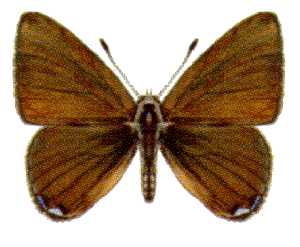
Acrodipsas brisbanensis, the bronze ant-blue or large ant-blue, is a butterfly of the family Lycaenidae. It is found in Australia.

Acrodipsas cuprea, the copper ant-blue or cuprea ant-blue, is a butterfly of the family Lycaenidae. It is found in Australia, from southern Queensland to Victoria.

Acrodipsas myrmecophila, the small ant-blue, is a butterfly of the family Lycaenidae. It is found in the south-east of Australia.

Ogyris zosine, the northern purple azure, is a member of the family Lycaenidae.

Myrmecodia beccarii, ant-house plant, is an epiphytic plant on Melaleuca trees and others with spongy bark in the wetlands and mangroves of tropical north Queensland, Australia from Cooktown to Mission Beach. The prickly, swollen stems develop natural hollows which are invaded by the golden ant in a symbiotic arrangement. The ants patrol the plant, removing leaf-eaters, while their excreta is absorbed by the plant for nutrition.

Allosmaitia wildei, the small oakblue or white oakblue, is a butterfly of the family Lycaenidae. It is found in Irian Jaya, western New Guinea, and from Cape York to Innisfail in northern Queensland, Australia.

Erikssonia edgei, commonly known as the Waterberg copper, tilodi copper or Edge's acraea copper, is an obligate myrmecophylous lycaenid butterfly, which is native to Limpopo, South Africa. The critically endangered butterfly occurs in high-altitude grasslands on sandy substrates, and has only been obtained from the type and one subsequent locality. The population at the type locality, a farm in the Waterberg, went extinct about 12 years after its 1980 discovery. It was afforded species status in 2010, when no extant populations were known. The status of two populations, discovered in 2013 at a private nature reserve to the southeast, remains indeterminate.
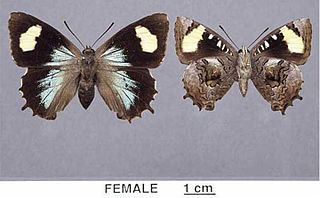
Ogyris genoveva, the genoveva azure or southern purple azure, is a butterfly of the family Lycaenidae. It is found in Australia.



















